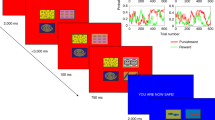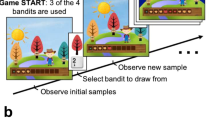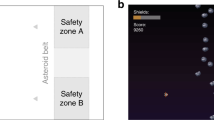Abstract
A goal of computational psychiatry is to ground symptoms in basic mechanisms. Theory suggests that avoidance in anxiety disorders may reflect dysregulated mental simulation, a process for evaluating candidate actions. If so, these covert processes should have observable consequences: choices reflecting increased and biased deliberation. In two online general population samples, we examined how self-report symptoms of social anxiety disorder predict choices in a socially framed reinforcement learning task, the patent race, in which the pattern of choices reflects the content of deliberation. Using a computational model to assess learning strategy, we found that self-report social anxiety was indeed associated with increased deliberative evaluation. This effect was stronger for a particular subset of feedback (‘upward counterfactual’) in one of the experiments, broadly matching the biased content of rumination in social anxiety disorder, and robust to controlling for other psychiatric symptoms. These results suggest a grounding of symptoms of social anxiety disorder in more basic neuro-computational mechanisms.
This is a preview of subscription content, access via your institution
Access options
Access Nature and 54 other Nature Portfolio journals
Get Nature+, our best-value online-access subscription
$29.99 / 30 days
cancel any time
Subscribe to this journal
Receive 12 digital issues and online access to articles
$119.00 per year
only $9.92 per issue
Buy this article
- Purchase on Springer Link
- Instant access to full article PDF
Prices may be subject to local taxes which are calculated during checkout





Similar content being viewed by others
Data availability
Processed data (per-participant estimated model parameters and covariates) supporting all of the statistical results of the study, and the raw choice data from which the model parameters were estimated, are available at https://github.com/ndawlab/patentrace. Raw psychometric data (questionnaire responses) are available from the corresponding authors upon request.
Code availability
Custom MATLAB code to reproduce all statistical results and tables is available at https://github.com/ndawlab/patentrace. Custom Julia code for estimating learning model parameters from raw choice data is available at https://github.com/ndawlab/em. Additional code (for figures and analyses of psychometric data) is available from the corresponding authors upon request.
References
Maia, T. V. & Frank, M. J. From reinforcement learning models to psychiatric and neurological disorders. Nat. Neurosci. 14, 154–162 (2011).
Huys, Q. J. M., Maia, T. V. & Frank, M. J. Computational psychiatry as a bridge from neuroscience to clinical applications. Nat. Neurosci. 19, 404–413 (2016).
Huys, Q. J. M. et al. Bonsai trees in your head: how the Pavlovian system sculpts goal-directed choices by pruning decision trees. PLoS Comput. Biol. 8, e1002410 (2012).
Moutoussis, M., Eldar, E. & Dolan, R. J. Building a new field of computational psychiatry. Biol. Psychiatry 82, 388–390 (2017).
Montague, P. R., Dolan, R. J. & Friston, K. J. Computational psychiatry. Trends Cogn. Sci. 16, 72–80 (2012).
Daw, N. D., Niv, Y. & Dayan, P. Uncertainty-based competition between prefrontal and dorsolateral striatal systems for behavioral control. Nat. Neurosci. 8, 1704–1711 (2005).
Johnson, A. & Redish, A. D. Neural ensembles in CA3 transiently encode paths forward of the animal at a decision point. J. Neurosci. 27, 12176–12189 (2007).
Mattar, M. G. & Daw, N. D. Prioritized memory access explains planning and hippocampal replay. Nat. Neurosci. 21, 1609–1617 (2018).
Schultz, W., Dayan, P. & Montague, P. R. A neural substrate of prediction and reward. Science 275, 1593–1599 (1997).
Daw, N. D., Gershman, S. J., Seymour, B., Dayan, P. & Dolan, R. J. Model-based influences on humans’ choices and striatal prediction errors. Neuron 69, 1204–15 (2011).
Otto, A. R., Gershman, S. J., Markman, A. B. & Daw, N. D. The curse of planning. Psychol. Sci. 24, 751–761 (2013).
Doll, B. B., Bath, K. G., Daw, N. D. & Frank, M. J. Variability in dopamine genes dissociates model-based and model-free reinforcement learning. J. Neurosci. 36, 1211–22 (2016).
Everitt, B. J. & Robbins, T. W. Neural systems of reinforcement for drug addiction: from actions to habits to compulsion. Nat. Neurosci. 8, 1481–1489 (2005).
Gillan, C. M. et al. Disruption in the balance between goal-directed behavior and habit learning in obsessive–compulsive disorder. Am. J. Psychiatry 168, 718–726 (2011).
Gillan, C. M. et al. Counterfactual processing of economic action–outcome alternatives in obsessive–compulsive disorder: further evidence of impaired goal-directed behavior. Biol. Psychiatry 75, 639–646 (2014).
Gillan, C. M., Kosinski, M., Whelan, R., Phelps, E. A. & Daw, N. D. Characterizing a psychiatric symptom dimension related to deficits in goal-directed control. eLife 5, e11305 (2016).
Reiter, A. M. F. et al. Behavioral and neural signatures of reduced updating of alternative options in alcohol-dependent patients during flexible decision-making. J. Neurosci. 36, 10935–10948 (2016).
Voon, V. et al. Disorders of compulsivity: a common bias towards learning habits. Mol. Psychiatry 20, 345–52 (2015).
Huys, Q. J. M., Daw, N. D. & Dayan, P. Depression: a decision-theoretic analysis. Annu. Rev. Neurosci. 38, 1–23 (2015).
Gagne, C., Dayan, P. & Bishop, S. J. When planning to survive goes wrong: predicting the future and replaying the past in anxiety and PTSD. Curr. Opin. Behav. Sci. 24, 89–95 (2018).
Solway, A., Lohrenz, T. & Montague, P. R. Loss aversion correlates with the propensity to deploy model-based control. Front. Neurosci. 13, 915 (2019).
Zorowitz, S., Momennejad, I. & Daw, N. D. Anxiety, avoidance, and sequential evaluation. Comput. Psychiatry 4, 1 (2020).
Faulkner, P. et al. A comparison of “pruning” during multi-step planning in depressed and healthy individuals. Psychol. Med. https://doi.org/10.1017/S0033291721000799 (2021).
Shapiro, D. N., Chandler, J. & Mueller, P. A. Using Mechanical Turk to study clinical populations. Clin. Psychol. Sci. 1, 213–220 (2013).
Norton, A. R. & Abbott, M. J. Self-focused cognition in social anxiety: a review of the theoretical and empirical literature. Behav. Change 33, 44–64 (2015).
Rapoport, A. & Amaldoss, W. Mixed strategies and iterative elimination of strongly dominated strategies: an experimental investigation of states of knowledge. J. Econ. Behav. Organ. 42, 483–521 (2000).
Zhu, L., Mathewson, K. E. & Hsu, M. Dissociable neural representations of reinforcement and belief prediction errors underlie strategic learning. Proc. Natl Acad. Sci. USA 109, 1419–1424 (2012).
Set, E. et al. Dissociable contribution of prefrontal and striatal dopaminergic genes to learning in economic games. Proc. Natl Acad. Sci. USA 111, 9615–9620 (2014).
Camerer, C. & Ho, T. H. Experience-weighted attraction learning in normal form games. Econometrica 67, 827–874 (1999).
Cushman, F. & Morris, A. Habitual control of goal selection in humans. Proc. Natl Acad. Sci. USA 112, 13817–13822 (2015).
Liu, Y., Mattar, M. G., Behrens, T. E. J., Daw, N. D. & Dolan, R. J. Experience replay is associated with efficient nonlocal learning. Science 372, eabf1357 (2021).
Kocovski, N. L., Fleming, J. E., Hawley, L. L., Ho, M. H. R. & Antony, M. M. Mindfulness and acceptance-based group therapy and traditional cognitive behavioral group therapy for social anxiety disorder: mechanisms of change. Behav. Res. Ther. 70, 11–22 (2015).
Kocovski, N. L., Endler, N. S., Rector, N. A. & Flett, G. L. Ruminative coping and post-event processing in social anxiety. Behav. Res. Ther. 43, 971–984 (2005).
Crump, M. J. C., McDonnell, J. V. & Gureckis, T. M. Evaluating Amazon’s Mechanical Turk as a tool for experimental behavioral research. PLoS ONE 8, e57410 (2013).
Liebowitz, M. R. Social phobia. Mod. Probl. Pharmacopsychiatry 22, 141–73 (1987).
Mennin, D. S. et al. Screening for social anxiety disorder in the clinical setting: using the Liebowitz Social Anxiety Scale. J. Anxiety Disord. 16, 661–673 (2002).
Bilker, W. B. et al. Development of abbreviated nine-item forms of the Raven’s standard progressive matrices test. Assessment 19, 354–69 (2012).
Brozovich, F. & Heimberg, R. G. An analysis of post-event processing in social anxiety disorder. Clin. Psychol. Rev. 28, 891–903 (2008).
Beck, A. T., Emery, G. & Greenberg, R. L. Anxiety disorders and phobias: a cognitive approach (Basic, 1985).
Clark, D. A. & Wells, A. in Social Phobia: Diagnosis, Assessment, and Treatment (eds Heimberg, R. G. et al.) (Guildford Press, 1995).
Hofmann, S. G., Carpenter, J. K. & Curtiss, J. in Science and Practice in Cognitive Therapy: Foundations, Mechanisms, and Applications (eds Leahy, R. L. et al.) 124–141 (Routledge, 2018).
Watkins, E. R. Constructive and unconstructive repetitive thought. Psychol. Bull. 134, 163–206 (2008).
Keramati, M., Smittenaar, P., Dolan, R. J. & Dayan, P. Adaptive integration of habits into depth-limited planning defines a habitual-goal-directed spectrum. Proc. Natl Acad. Sci. USA 113, 12868–12873 (2016).
Icard, T., Cushman, F. & Knobe, J. On the instrumental value of hypothetical and counterfactual thought. Proceedings of the 40th Annual Conference of the Cognitive Science Society 517–522 (2018).
Caplin, A., Dean, M. & Leahy, J. Rationally Inattentive Behavior: Characterizing and Generalizing Shannon Entropy Working paper no. 23652 (NBER, 2017).
Kahneman, D. & Miller, D. T. Norm theory. Comparing reality to its alternatives. Psychol. Rev. 93, 136–153 (1986).
McCloy, R. & Byrne, R. M. J. Counterfactual thinking about controllable events. Mem. Cogn. 28, 1071–1078 (2000).
Loomes, G. & Sugden, R. Regret theory: an alternative theory of rational choice under uncertainty. Econ. J. 92, 805 (1982).
Raven, J. The Raven’s progressive matrices: change and stability over culture and time. Cogn. Psychol. 41, 1–48 (2000).
Zhu, L., Jiang, Y., Scabini, D., Knight, R. T. & Hsu, M. Patients with basal ganglia damage show preserved learning in an economic game. Nat. Commun. 10, 802 (2019).
Erev, I. & Roth, A. E. Predicting how people play games: reinforcement learning in experimental games with unique, mixed strategy equilibria. Am. Econ. Rev. 88, 848–881 (1998).
Cheung, Y. W. & Friedman, D. Individual learning in normal form games: some laboratory results. Games Econ. Behav. 19, 46–76 (1997).
Brown, G. W. Iterative solution of games by fictitious play. Act. Anal. Prod. Allocation 13, 374–376 (1951).
Sutton, R. S. Dyna, an integrated architecture for learning, planning, and reacting. ACM SIGART Bull. 2, 160–163 (1991).
Amaldoss, W. & Jain, S. David vs. Goliath: an analysis of asymmetric mixed-strategy games and experimental evidence. Manag. Sci. 48, 972–991 (2002).
Vikbladh, O. M. et al. Hippocampal contributions to model-based planning and spatial memory. Neuron 102, 683–693.e4 (2019).
Keramati, M., Dezfouli, A. & Piray, P. Speed/accuracy trade-off between the habitual and the goal-directed processes. PLoS Comput. Biol. 7, e1002055 (2011).
Bezanson, J., Edelman, A., Karpinski, S. & Shah, V. B. Julia: a fresh approach to numerical computing. SIAM Rev. 59, 65–98 (2017).
Acknowledgements
The authors thank Q. Huys, M. Paulus, M. Stein, A. Solway and S. Zorowitz for helpful conversations. This work was supported by NIMH grant R01MH121093, part of the CRNCS programme, and by a Scholar Award from the James S. McDonnell Foundation. The funders had no role in study design, data collection and analysis, decision to publish or preparation of the manuscript.
Author information
Authors and Affiliations
Contributions
L.E.H., E.A.M., C.M.G., M.H. and N.D.D. contributed to the conception and design of the experiment L.E.H. and E.A.M. collected the data. L.E.H., E.A.M. and N.D.D. analysed the data. L.E.H. and N.D.D. prepared the initial draft of the manuscript, and all authors edited the manuscript and gave final approval of revisions.
Corresponding authors
Ethics declarations
Competing interests
The authors declare no competing interests.
Additional information
Peer review information Nature Human Behaviour thanks Camilla Nord and the other, anonymous, reviewer(s) for their contribution to the peer review of this work.
Publisher’s note Springer Nature remains neutral with regard to jurisdictional claims in published maps and institutional affiliations.
Supplementary information
Supplementary Information
Supplementary Tables 1–10 and Figs. 1–5.
Rights and permissions
About this article
Cite this article
Hunter, L.E., Meer, E.A., Gillan, C.M. et al. Increased and biased deliberation in social anxiety. Nat Hum Behav 6, 146–154 (2022). https://doi.org/10.1038/s41562-021-01180-y
Received:
Accepted:
Published:
Issue Date:
DOI: https://doi.org/10.1038/s41562-021-01180-y
This article is cited by
-
Better social reversal learning is associated with a more social approach across time
Scientific Reports (2024)
-
The effect of VTL model with digital technique on promoting system 1 to system 2 switch for creative thinking: a five-year study through a global pandemic
Education and Information Technologies (2024)
-
Inattentive responding can induce spurious associations between task behaviour and symptom measures
Nature Human Behaviour (2023)
-
Decision heuristics in contexts integrating action selection and execution
Scientific Reports (2023)
-
Differential replay of reward and punishment paths predicts approach and avoidance
Nature Neuroscience (2023)



